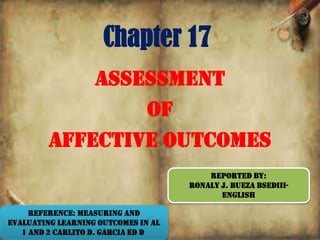
Assessment ofaffectiveoutcomes
- 1. Chapter 17 Assessment of Affective Outcomes REPORTED BY: RONALY J. BUEZA BSEDIII- ENGLISH Reference: Measuring and Evaluating Learning Outcomes in AL 1 and 2 Carlito D. Garcia Ed D
- 2. Forced-Choice Selection Methods • A forced-choice item the respondent to select among choices that differ on content, rather than the degree of favorableness or intensity. •The examinee is directed to indicate which of several action, contents, or object is most characteristic of him or her. •The format is similar to that of a multiple choice item or it may be a description of a situation with associated questions, or a pair of choice statements.
- 3. Advantage of the forced-choice pattern(According to Oppenhiem(1999) Minimizes the subjective element in judgment; Reduces the respondent’s ability to produce a desired outcome and therefore less fake able; Produces a better distribution and spread of scores with less piling up and skewness; Is quick, efficient, objective and lends itself to machine-scoring; and Produces scores easily analyzed with respect to reliability and validity.
- 4. The Method of Summated Rating or Likert Scales • One of the most frequently used response style in attitude measurement is the Likert scale, Which is usually a five-point scale that links options ”strongly agree” and “strongly disagree.” In this kind of rating scale, The students respond to statements by choosing the options that most closely represent their feelings about the statements. • The usual response categories are as follows: strongly agree; agree; uncertain or undecided; disagree; and strongly disagree. • Numerical weights ; 5 for strongly agree; 4 for agree; 3 for undecided or uncertain; 2 for disagree; And 1 for strongly disagree.
- 5. The Semantic Different Technique • This technique is not a test procedure but a general method of obtaining ratings of concepts in a series of bipolar adjective scales. • It is designed so that attitudes, feelings, and opinions can be measured by disagree, from very favorable to highly unfavorable.
- 6. In the semantic differential scale, the respondent checks the blank on the continuum that corresponds to his feelings about the stimulus word. Identify the concept/s to be rated. The number and type of concepts to be selected will depend upon the intent. It is best to select a group of related concepts that can be viewed within the same context or frame of reference. Choose appropriate bipolar scales. Examples of paired opposite adjectives that can be used are the following: good- bad; sweet-sour; high-low; kind-cruel; pleasant-unpleasant; valuable-worthless; brave-cowardly; honest-dishonest; healthy- sick; relaxed-tense and many more. The difficulty level of the words should be considered as students cannot use adjectives whose meanings they don’t understand.
- 7. Design a response sheet. Only one concept should appear on each page and the scales listed beneath. The polarity of the scales should be alternated. You may use 5 to 7-point scale. Nonetheless, 10 to 15 adjective pairs would be sufficient for a group of about 10 related concepts. The younger the group, the fewer concepts and scales should be used. Write instructions . The cover sheet should include a general orientation to the task and statement about why data are being collected. The significance of the scale positions should be specified, as well as the procedure for responses. An example of a standard set of instructions for a semantic differential exercise is cited below.
- 8. Free Response and Opinionnaire Methods • The opinionnaire is used frequently in the polling method of gathering opinion and attitude data. The use of a well-constructed opinionnaire can systematize the data-gathering process and help ensure that relevant questions are asked and all important aspects of a problem surveyed.
- 9. To be considered in preparing an opinionnaire.(according to Gable,1996) Brevity; Inclusion of items of interest and face appeal to attract the attention of the respondent and cause him to become involved in the task; Provision for depth of response in order to avoid superficial replies; Wording of questions neither too suggestive nor too unstimulating; Phrasing of questions so they are not too narrow in scope, allowing the respondent reasonable latitude in his responses. Reference: Measuring and Evaluating Learning Outcomes in AL 1 and 2 Carlito D. Garcia Ed D